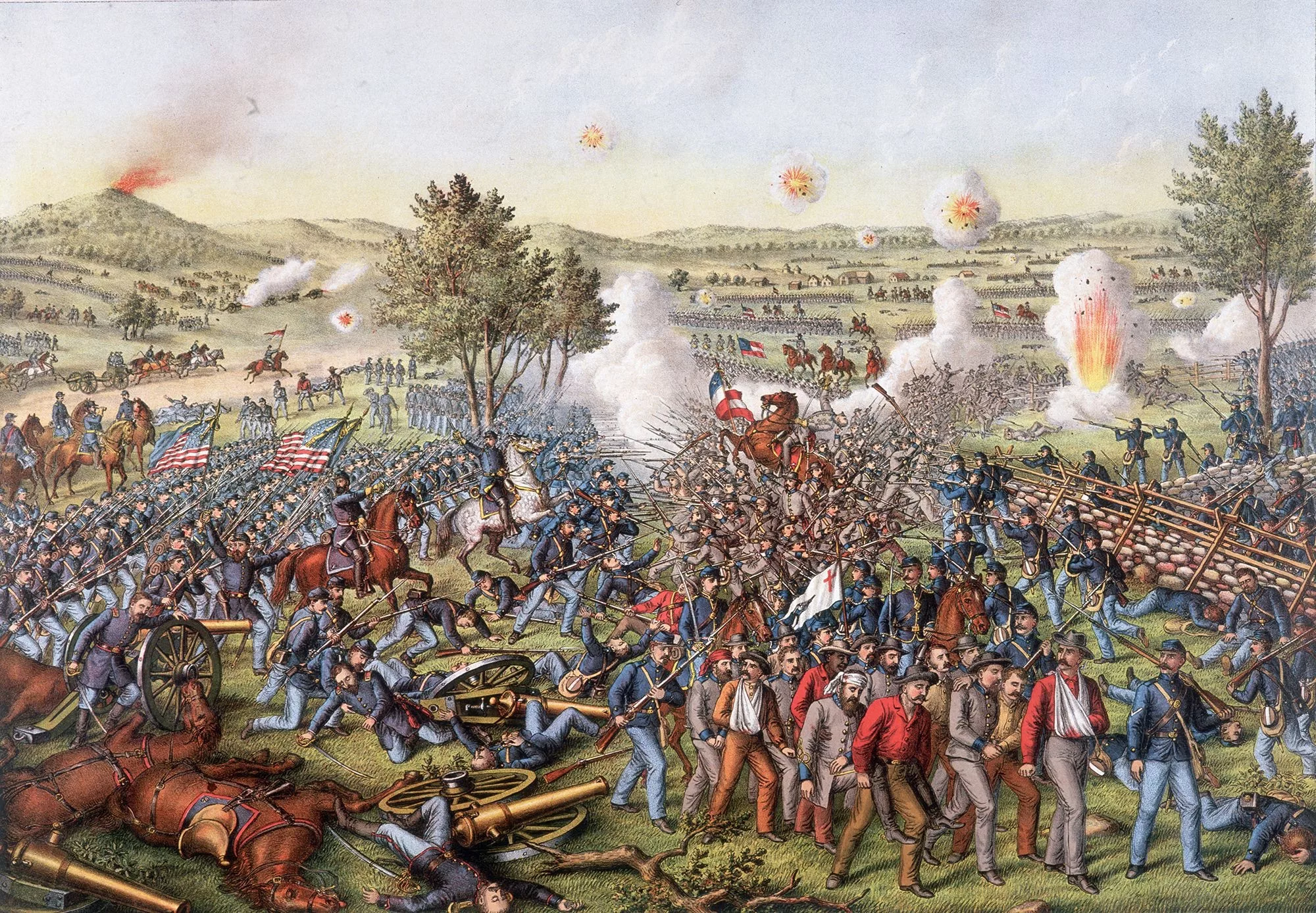When the American Civil War began in 1861, few believed it would last four years and claim more lives than any conflict in U.S. history. The Confederacy—formed by 11 Southern states that seceded from the Union—believed deeply in its cause: states’ rights, sovereignty, and the preservation of slavery. Many in the South felt they had the better generals, the stronger will to fight, and the moral high ground of defending their homes.
Yet by 1865, the Confederacy lay in ruins. Cities were burned, plantations destroyed, and slavery abolished. So what went wrong? Why did the South lose the Civil War despite its early battlefield successes and passionate support for independence?
The answer isn’t simple. It wasn’t just about better generals or larger armies. The South lost due to a convergence of structural disadvantages, misguided strategies, economic weaknesses, and critical leadership failures. This was a war not just of bullets and bayonets—but of ideology, industry, and endurance.
The North Had More of Everything
A Crushing Advantage in Population and Resources
At the start of the war, the Union had more than twice the population of the Confederacy—roughly 22 million people compared to the South’s 9 million, of whom 3.5 million were enslaved and barred from fighting until late in the conflict. This demographic imbalance meant the Union had a far deeper pool of soldiers, laborers, and workers.
More than that, the North had the lion’s share of factories, railroads, and infrastructure. The Union controlled over 80% of the nation’s manufacturing capacity, including almost all arms production. The South relied heavily on imported goods, which were quickly cut off by the Union’s naval blockade—a decisive strategic move that strangled the Confederate economy.
Railroads and Logistics
The North’s extensive railroad network allowed for rapid movement of troops and supplies, enabling Union generals to maintain momentum across vast distances. In contrast, the Confederacy’s infrastructure was patchy, and many Southern rail lines were incompatible due to different track gauges. This logistical disadvantage grew more crippling as the war dragged on.
Economic Fragility and the Collapse of “King Cotton”
Overreliance on a Single Crop
The South’s economy was based almost entirely on agriculture, particularly cotton. Southern leaders believed that their cotton was so vital to European textile mills that countries like Britain and France would be forced to intervene on their behalf. This belief was dubbed “King Cotton Diplomacy.”
But it backfired. Britain and France had large cotton reserves and soon found new suppliers in Egypt and India. Europe, while economically interested in the South, wasn’t eager to ally with a slave-holding power—especially once Lincoln issued the Emancipation Proclamation, reframing the war as a moral crusade.
Inflation and Starvation
Without access to international markets and with no diversified economy, the Confederate government began printing money to finance the war. The result was runaway inflation. In just a few years, the Confederate dollar became nearly worthless. By 1864, bread riots were breaking out in Southern cities, and entire communities were on the brink of starvation.
Internal Division and Lack of Unity
States’ Rights Undermining Central Authority
Ironically, the Confederacy’s foundational commitment to states’ rights hampered its war effort. While the Union could impose taxes, raise large armies, and coordinate logistics under a strong central government, the Confederate states often resisted Richmond’s authority. Governors hoarded supplies and refused to send troops across state lines. This lack of coordination proved fatal in a war that required national unity.
Political Weaknesses and Jefferson Davis
While Abraham Lincoln gradually grew into one of the most effective wartime leaders in American history, Confederate President Jefferson Davis struggled. A skilled orator but poor administrator, Davis was inflexible, micromanaging generals while failing to rally a divided political landscape. His inability to delegate and his resistance to necessary reforms—like the arming of enslaved people—left the Confederacy paralyzed at crucial moments.
Military Strategy and Battlefield Mistakes
The Myth of Southern Superiority
It’s true that the South had brilliant battlefield commanders like Robert E. Lee, Stonewall Jackson, and J.E.B. Stuart. They often won impressive victories despite being outnumbered. But these victories were tactical, not strategic. The South lacked a long-term plan to win the war outright. Lee’s invasions of the North—particularly the Battle of Gettysburg in 1863—were meant to break Northern morale but ultimately ended in disaster.
Meanwhile, Union generals like Ulysses S. Grant and William Tecumseh Sherman focused on total war: not just defeating Confederate armies, but destroying the South’s capacity to continue fighting. Sherman’s March to the Sea laid waste to Georgia’s infrastructure and food supply, while Grant’s relentless siege tactics eventually ground Lee’s army down.
No Exit Plan
The South’s military strategy essentially depended on convincing the North to quit. But the Union’s morale, though tested, held firm—especially after major victories in 1863. Once the Union committed to total war and began leveraging its full economic and population advantage, the South had no viable path to victory. It could win battles, but not the war.
Slavery: The Central Contradiction
Fighting to Preserve a Flawed System
At its core, the Confederacy was fighting to preserve slavery, though many Southerners framed the war as a battle for liberty and self-determination. This ideological contradiction—demanding freedom while denying it to millions—undermined the South’s moral authority at home and abroad.
More pragmatically, slavery limited the South’s ability to mobilize manpower. Not until 1865, mere months before surrender, did the Confederate Congress approve arming enslaved men—a move that was far too late and deeply unpopular among Southern elites.
The Union’s Moral Pivot
Initially, many Northerners had little interest in ending slavery. But Lincoln’s Emancipation Proclamation in 1863 changed that. It turned the war into a moral crusade and paved the way for Black soldiers to join the Union Army. By war’s end, nearly 180,000 Black men had served in Union ranks—many of them formerly enslaved—giving the North both a manpower and ideological advantage.
International Isolation
Failure to Gain Recognition
Unlike the American Revolution, where France provided critical aid to the colonists, the Confederacy received no official support from any major foreign power. Britain and France, despite economic ties to Southern cotton, remained neutral. The South’s insistence on maintaining slavery, and its inability to prove it could win, discouraged diplomatic recognition.
Blockade and Isolation
The Union’s naval blockade, part of the Anaconda Plan, was surprisingly effective. It cut the South off from foreign weapons, goods, and currency. Smuggling continued, but at a trickle. Over time, this isolation exacerbated the South’s economic crisis and destroyed its chances of international rescue.
War Weariness and Civilian Collapse
A Broken Home Front
By 1864, the Southern civilian population was exhausted. Inflation made food unaffordable. Railroads and factories were destroyed. Families had lost sons, husbands, and fathers. Desertion among Confederate troops rose sharply. Women staged food riots. Many Southerners began to lose faith in the cause.
The Union, while also weary, had better infrastructure, better communication, and a functioning political system to sustain the war effort. Lincoln’s reelection in 1864, after key victories, sealed the fate of the Confederacy.
The Fall of Richmond and Lee’s Surrender
In April 1865, Union forces finally broke through Confederate lines at Petersburg, forcing the evacuation of Richmond, the Confederate capital. General Robert E. Lee surrendered to General Ulysses S. Grant at Appomattox Court House on April 9, 1865. Other Confederate armies soon followed. The war was over. The Confederacy, never officially recognized, ceased to exist.
Conclusion: The South Couldn’t Win a War of Attrition
The South didn’t lose the Civil War because it lacked bravery or leadership on the battlefield. It lost because it was fighting an unwinnable war on almost every front—economic, political, diplomatic, moral, and logistical. It gambled on foreign intervention that never came, relied on an economy that collapsed, and upheld a social system—slavery—that doomed its moral standing and strategic flexibility.
Meanwhile, the Union adapted. It harnessed its superior resources, shifted to total war, embraced emancipation, and kept its political house (mostly) in order. In the end, the North simply had more of everything—and enough resolve to see the war through.
The defeat of the Confederacy preserved the United States and ended slavery. But the scars of that conflict—regional, racial, and ideological—would shape American society for generations to come.
The Civil War was a tragedy of epic proportions. The South’s defeat wasn’t inevitable—but it became so, one misstep and one disadvantage at a time.




